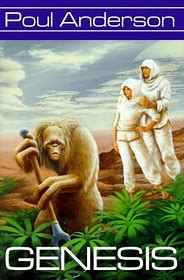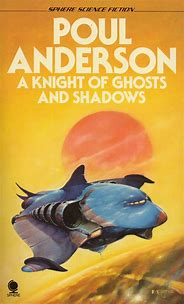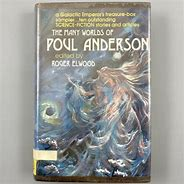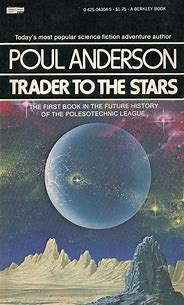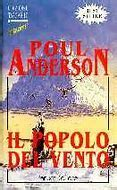Thursday, 29 February 2024
Details: Introduction And Convergence
Wednesday, 28 February 2024
Anderson's GENESIS
I think that Poul Anderson's Genesis is the most advanced futuristic speculation and will not be outdated in the foreseeable future but maybe this is just because I am not familiar with more recent works by other authors?
Issues In Future Histories
Robert Heinlein's Future History: Technology progresses but society regresses until a technologically based religious dictatorship has to be overthrown but then, after some further difficulties, the first mature civilization emerges.
Isaac Asimov's Foundation: A predictive science of society is used merely to manipulate populations without their knowledge or consent. A mental science becomes merely a means of mental control.
Frank Herbert's Dune: Power politics. Paul Atreides gains sole control of a unique natural resource with the result that other factions unite against him.
Poul Anderson's Psychotechnic History: A predictive science of society is applied with mixed results.
Poul Anderson's Technic History, in particular A Knight Of Ghosts And Shadows: A serious discussion of how bad decisions might prevent the free growth of a society, thus causing successive stages of decline.
Poul Anderson's Genesis: Post-organic intelligence.
There are others, of course.
Watching DUNE
Observations:
Interstellar empires, complete with Emperors, are big in American sf! What happened to Presidents? In James Blish's The Quincunx of Time, the President of the Milky Way announces federation with the Magellanic Clouds in 3480. In Isaac Asimov's The Stars Like Dust, the Constitution of the United States is considered for use on an interstellar scale. However, in novels set later in that future history, there is a Trantorian Empire that becomes the Galactic Empire. Dune presents an already established Empire whereas Anderson shows us the rise, decline and fall of the Terran Empire together with some very different and plausible individual Emperors.
Herbert presents organized religion only as a vehicle for cynical manipulation of planetary populations whereas Anderson shows us genuine piety and devotion, e.g., in Kossara Vymezal who wants to be married in St. Clement's Cathedral by Father Smed who had christened and confirmed her. Andrea went as far as to say that the evil of organised religion was the entire point of Dune but that might be going too far.
Tuesday, 27 February 2024
Zmay Religion
Trodhwyr is:
Time Scales
In Anderson's Genesis, we find the following time scales:
Beginnings And Endings ( A Familiar Theme)
EARTH BOOK And Flandry
Monday, 26 February 2024
Lords And An Ogre Planet
"Imagine, my lords." (p. 97)
The first person narrator addresses his "lords." We wonder whether we will see these lords before the story ends. We do not but by then we have forgotten about them - but their mere presence at this stage tells us something about the kind of society that is involved here. These mariners are not on Earth:
they had "...sailed from Lavre Town..." (ibid.);
they seek "'...the Aureate Cities...'" (ibid.);
they steer by an "...ogre planet..." (ibid.) that ascends as they sail west;
they hear sea monsters breaching at night;
the ogre planet is called "Tambur" (p. 98) -
- and so on.
Of course, it turns out that this human population has "'...Fall[en] From Heaven.'" (p. 102) This means that they are descendants of extra-planetary space travellers but have lost the secret of space travel. What will they find when sailing west and will they re-establish contact with "Heaven"? Poul Anderson knows exactly where he is going with this narrative but we must read on to find out.
Visuals
I imagine not only cinematic but also graphic adaptations of Poul Anderson's Technic History. At the beginning of The Earth Book Of Stormgate, we should see Hloch on Mount Anrovil in the Weathermother followed by scenes of everything that he mentions:
The Significance Of The EARTH BOOK
The Past Through Tomorrow (Putnam, 1967), Heinlein's Future History revised and almost complete, collects twenty-one instalments, including two novels. That is indeed almost complete and the two remaining stories, collected as Orphans Of The Sky, do not really advance the history of mankind. They merely recount some subsequent subsidiary events.
It is impossible that the Earth Book alone should contain Anderson's Technic History "almost complete" since that future history series comprises forty-three instalments, including eleven full length novels. That history is complete in seven omnibus volumes as Baen Books' The Technic Civilization Saga. But the Earth Book, considered as a single volume, is pivotal. It collects over a quarter of the instalments, including one full novel. Some regular blog readers will probably find it tedious that I have made several attempts to summarize the contributions made by the Earth Book. The summary remains recognizably the same but also grows as I come to appreciate further aspects of the collection.
The Earth Book Of Stormgate:
has a very good, and also appropriate, cover illustration;
"Spans, illuminates and completes the magnificent future history of the Polesotechnic League," as its front cover blurb rightly proclaims;
is the fifth Polesotechnic League volume and the second Ythrian volume;
completes the history of the Polesotechnic League and almost completes the history of human-Ythrian interactions;
presents twelve new introductions and one afterword that substantially enhance the Technic History;
refers to the Terran Empire although not to Dominic Flandry because that important character has not been born yet;
prepares the way for the nine-volume Flandry Period and its single-volume sequel.
This summary conveys to its readers that the Technic History comprises at least sixteen volumes. In fact, three further stories could be collected as an additional volume to be read between the fourth Polesotechnic League volume and the first Ythrian volume, thus making the total number of volumes seventeen. OK: I am obsessed not only with the content but also with the structure of the Technic History and everything becomes focused through the Earth Book.
Saturday, 24 February 2024
Comparing Three Editions Of "The Longest Voyage"
Is Rovic Right?
If Val Nira is helped to depart in his Sky Ship, then his people will return and will immediately reincorporate this long isolated planet into interstellar civilization. In order to prevent that outcome, Captain Rovic stuffs the Ship with gunpowder and blows it up. He does not, as I had misremembered, deliberately kill Val Nira although the latter is in fact killed when he runs toward the Ship as it is about to explode.
Rovic's reason:
Governments
Friday, 23 February 2024
What Val Nira Said
"'No nation on this world could even reach my people unaided - let alone fight them - but why should you think of fighting? I've told you a thousand times, Isklip, the dwellers in the Milky Way are dangerous to none, helpful to all. They have so much wealth, they're hard put to it to find a use for most of it. Gladly would they spend large amounts to help all the peoples on this world become civilized again.'" (p. 120)
"Ah, greater marvels than the poets have imagined for Elf Land! Entire cities built in a single tower half a mile high. The sky made to glow so that there is no true darkness after sunset. Food not grown in the earth, but manufactured in alchemical laboratories. The lowest peasant owning a score of machines which serve him more subtly and humbly than might a thousand slaves - owning an aerial carriage which can fly him around his world in less than a day - owning a crystal window on which theatrical images appear, to beguile his abundant leisure. Argosies between suns, stuffed with the wealth of a thousand planets; yet every ship unarmed and unescorted, for their are no pirates and this realm has long ago come to such good terms with the other starfaring nations that war has also ceased.'" (pp. 126-127)
"The Longest Voyage" In The Technic History?
Maybe he exaggerates in order to impress his hosts and gain their cooperation?
Maybe his long isolation has deranged him so that he has lost touch with reality?
Since known space is a big place, maybe he comes from a region that is more advanced?
Maybe he comes from one of the post-Technic civilizations in the further future after "Starfog"?
Normally, I would start into quoting and analysing the details of what he does say but life is busy here right now. Maybe this evening.
Wednesday, 21 February 2024
God's Daughter
These guys have a fairly good approximation to Christianity:
Before The Fall
"The Longest Voyage."
Inhabitants of the planet where this story is set have their own bizarre myth to explain why:
"'...men must work...'" (p. 99)
Originally, human beings could command their environment but this made one man so lazy that God withdrew the power. They also refer to a Fall:
"...since the Fall of Man..." (ibid.)
An attempt to explain gravitation:
"'The same pressure, maybe, that hurled mankind down onto the earth, at the time of the Fall From Heaven.'" (p. 102)
"'Scripture tells us man dwelt beyond the stars before the Fall.'" (p. 108)
OK. An extra-solar colony has lost space travel, has retrogressed scientifically and now confuses the Biblical Fall with their ancestors' descent from space onto this planetary surface: "the Fall."
We find the same theology in another sf work. See All That Fall.
"Among Thieves"
Our present project is to reread some non-series Poul Anderson short stories that occupy the same "imaginative space," or whatever we want to call it, as his Technic History: FTL space travel; extra-solar colonies, interstellar civilization. So far, there are three stories on the agenda:
Wind On An Ocean
Tuesday, 20 February 2024
Imaginary Space II
We saw that there is a vast body of sf that shares premises (i)-(vi). Conventionally, stories set in this vast set of imaginary spaces either are instalments in some particular series or are one-off, stand-alone narratives. Authors could be freer to mix and match elements of different stories and sometimes do but usually they stay with the conventional distinction between series and non-series stories.
Thus, both "The Longest Voyage" and "High Treason" by Poul Anderson are one-off stories that do not fit into his Technic History or into any other such series but nevertheless are recognizably part of that larger imaginary space, or set of spaces, that includes FTL and related premises.
I have a problem that will be familiar to other readers of sf and particularly of Poul Anderson. I remember a story by Anderson but not its title. I thought that the story was in a collection in my possession but now cannot find the story. There was FTL. Human beings had colonized extra-solar planets. One planetary population had mutated and now lacked normal human motivations. A naval expedition crewed by members of a master race and of a subordinate race embarked on an expedition. By clandestine prearrangement, the subordinate class mutinied and slaughtered their masters in space. When the action of the story moved back to Earth, we learned that the centre of political power was now in Africa. Does anyone know what I am talking about?
Imaginary Space
(i) that faster than light (FTL) interstellar travel is possible - a tall order;
(ii) that such travel will become easily affordable, at least to some sections of society, and will even become an entirely routine matter like contemporary air travel - a considerably taller order;
(iii) that many uninhabited terrestroid extra-solar planets are humanly colonizable without needing to be terraformed;
(iv) that there are also many inhabited planets;
(v) that human beings will quickly communicate and interact with the inhabitants of such planets;
(vi) thus, that civilization, trade and warfare will, in the next few centuries, occur on an interstellar scale - that contemporary human international relations will simply be continued in future human and non-human interstellar relations.
Does that seem implausible and anthropomorphic to you? There is a non-human universe out there. What is it really like? Premise (iii) has become a lot more plausible in my life-time but I remain sceptical about the rest.
Poul Anderson wrote sf that accepted these premises but also other sf that did not.
Robert Heinlein, James Blish and Poul Anderson thought about these premises, instead of just assuming them, and tried to make FTL believable. Blish's main future history begins with the composite premise that both FTL and antiagathics are necessary for interstellar travel. Heinlein's Future History has the long-lived Howard Families hijacking a generation ship, then a mathematical genius inventing the FTL drive in flight. In Heinlein's Time For The Stars, a slower than light interstellar expedition confirms that telepathy operates instantaneously across interstellar distances, thus providing a theoretical basis for an instantaneous irrelevant drive. The most ingenious FTL drive is Anderson's quantum jump hyperdrive although he also imagined several others. But, in one later story, Blish as author commented on this whole idea by labelling his newest version of an FTL drive the "Imaginary Drive."
The League Returns
describes the first civil war in the Polesotechnic League - a conflict, furthermore, that initiates the beginning of the end of the League;
is the concluding volume of Anderson's Polesotechnic League Tetralogy where it is preceded by two collections, Trader To The Stars and The Trouble Twisters, and by one previous novel, Satan's World;
in terms of fictional chronology, is the last instalment in the Polesotechnic League sub-series of Anderson's major future history series, the History of Technic Civilization;
is followed first by the novel, The People Of The Wind, set centuries later in a different volume of space, and secondly by The Earth Book Of Stormgate, an omnibus collection compiled, in terms of the fictional chronology, shortly after the events of The People Of The Wind.
This third novel and third collection constitute an "Ythrian" diptych that is the second main section of the Technic History after the aforementioned Polesotechnic League Tetralogy.
Someone who has consecutively read through the Tetralogy, The People Of The Wind and the two opening Ythrian short stories in the Earth Book could be forgiven for thinking that by now he has left the Polesotechnic League far behind in both space and time. However, if he has appreciated:
Thursday, 15 February 2024
Planetary Parameters
Poul Anderson outlines this in his AFTERWORD to The Man Who Counts:
Wednesday, 14 February 2024
Avalonians Learn Their History
about Nicholas van Rijn in Trader To The Stars;
about David Falkayn in The Trouble Twisters;
about both in Satan's World and Mirkheim;
and about the antecedents and origins of the Avalonian colony in The Earth Book Of Stormgate.
The series progresses and broadens out instead of remaining focused on a single individual.
The Avalonians learn about van Rijn and Falkayn in reverse order. They already knew about Falkayn because he had founded their colony but, in the Earth Book, they must be informed or at least reminded that Falkayn had been a protege of van Rijn. This explains why Hloch, editing the Earth Book, includes within it the first van Rijn story, "Margin of Profit." The real world reason why "Margin of Profit" had not been included in Trader To The Stars, although it was quoted there, was that its text had to be revised to make it consistent with the rest of the Technic History.
Hloch writes:
The Internet And Library Central
Daily Life In Three Future Histories
Tuesday, 13 February 2024
Everyday Life On Avalon
First, his parents, Ferannian and Rennhi:
"...held the country around Spearhead Lake..." (p. 75) (For full reference, see here.)
(Poul Anderson was merely inventing extra details for the sake of these framing passages in an omnibus collection. However, these newly invented details enhance our future historical knowledge, nevertheless.)
Ferannian, an engineer, met human beings during many visits to Gray, Centauri and other towns.
Travel routes crisscrossed above Spearhead Lake and there was also a nearby copper mine.
Some Ythrians, including Hloch's parents, are "guest-free," meaning that they have house guests for several days at a time, allowing them to roam and hunt.
Stormgate is close to Gray and therefore accepts many human Avalonians into membership.
All this adds up to Hloch having many human acquaintances which qualifies him to edit the Earth Book.
Saga And Earth Book
We already know that:
Stormgate is the name of an Avalonian choth;
Avalon is a human colony planet with a large Ythrian minority;
the "choth" is the basic unit of Ythrian social organization after the family;
Ythrians are flying carnivores so their psychology, sociology and theology differ from ours.
Reading Hloch's first Earth Book INTRODUCTION which, in the Saga, comes near the beginning of Volume I, The Van Rijn Method, we find:
Winter And Summer (On Different Planets)
The People Of The Wind, XIX.
"The treaty was signed at Fleurville on a day of late winter." (p. 654)
Winter again so soon? Yes, Fleurville is on a different planet!
"Summer dwelt in Gray when word reached Avalon." (p. 659)
We have seen winter, spring and summer in Gray and winter on St. Li. Seasons pass in cyclical time while history is made in linear time.
Out last sight of Avalonian natural beauty:
north from Gray, a red and gold sunset above a quiet sea glimmering toward the darkening horizon;
trefoil and sword-of-sorrow growing amongst the imported grass;
the Avalonian evening star, we are not told its name;
ringing harp vines and twinkling jewelleafs.
The following morning, Eyath flies toward:
"...the mountains of home." (p. 662)
As I have quoted before:
Rain On Avalon
The People Of The Wind.
What might rain symbolize?
Eyath, alone, grieving:
"...rain fell, slow as tears." (XV, p. 606)
Rain as tears is obvious.
However, Eyath and Arinnian, now reconciled:
"Her head she lay murmuring against his shoulder. Raindrops glistened within the crest like jewels of a crown." (XIX, p. 654)
Rain as a crown! It all depends on the point of view, of course.
Also relevant is the following. Eyath with Tabitha:
"A strangled sound, though Ythrians do not weep." (XVIII, p. 648)
Since Ythrians do not weep, "...rain fell, slow as tears..." is human symbolism. Who makes this comparison? Is it the omniscient narrator or Eyath reflecting on human expression of grief?
Monday, 12 February 2024
Back In Gray
The People Of The Wind, XVIII.
When Tabitha visits Philippe in the hospital, we know that the window is:
"...open to the blue and blossoms of springtime." (p. 644)
- so we have got away from the winter that we saw in Gray and on St. Li but where are we now? He sees from her complexion that she has not been in Gray so is that where they are? Yes. When she leaves the building, we learn that it has:
"...been hastily erected on the outskirts of Gray." (p. 646)
- and then we read our last description of the city:
The Environment And The War II
The People Of The Wind, XVII.
A dust storm makes the sunset:
"...the color of clotted blood." (p. 634)
- a very appropriate pathetic fallacy. Back to the literal effects of the environment: in Scorpeluna, days are horribly hot, nights gnawingly cold. Avalon's high irradiation and rapid spin make tropical storms so unpredictable and also so violent that one such storm delays the Terran evacuation for a day and a night. The rain would have killed patients as they were carried from shacks to ships. Flash floods threaten the base. After the storm, by interdicting the escape route but offering medical help, the Avalonians gain a second Terran withdrawal and ceasefire.
The People Of The Wind and The Earth Book Of Stormgate are companion volumes. The characters, Lythran, Blawsa and Arinnian, introduced in The People Of The Wind, are referenced in the background information in Hloch's Earth Book introductions. The lethal aspects of the Avalonian environment, crucial to The People Of The Wind, are introduced in "The Problem of Pain" in the Earth Book. Ythri, seen briefly in The People Of The Wind, is explored in "Wings of Victory" in the Earth Book. Hloch's first introduction refers to the devastation caused by the Terran War which is the subject-matter of The People Of The Wind. It makes sense to read the Earth Book immediately after The People Of The Wind.
The Environment And The War
The People Of The Wind, XVII.
We are shown some glimpses of the Avalonian environment even during the onslaught of the second attack. The planetary environment, of course, includes the moon, Morgana. When Morgana is bombarded, its mountains crumble and its valleys run molten. Later, the moon is:
"...murky-spotted and less bright than formerly. So much had it been scarred." (XIX, p. 660)
During the attack, Terran Meteor boats, including Rochefort's, attack a missile launch silo which:
"...lay beyond the mountains, in the intensely green gorge of a river." (p. 631)
When the boats have finished:
"A set of craters gaped between cliffs which sonic booms had brought down in rubble. Rochefort wished he could forget how fair that canyon had been." (ibid.)
On the Scorpelunan plateau, where the invaders establish their bridgehead:
The Attack On Centauri
The People Of The Wind, XVII.
The Terrans are about to attack the Avalonian's chief seaport and industrial capital, Centauri. Two Terrans have this exchange:
Sunday, 11 February 2024
Imperial Intelligence About Avalon
The People Of The Wind, XVI.
Admiral Cajal has three sources of intelligence about Avalon.
(i) "'...our analysis of enemy fire patterns, as recorded at the first battle of Avalon, does indicate Equatoria is a weak spot.'" (p. 622)
(ii) Not only do Avalonian defectors bring some information with them but also officials secretly of the peace group have given some of the more recent defectors additional information to pass on.
(iii) Philippe Rochefort spent months on the planet and become closely acquainted with officers of the home guard, even including the son of the First Marchwarden.
Unsuspected problems (for the Terrans):
Equatoria is poorly defended but it will be disastrous to land there;
information fed to the defectors and to Rochefort has been designed to encourage the Terrans to land there.
The rest is future history.
Betrayals
The People Of The Wind, XV-XVI.
Some spy fiction - and presumably also spy life - features endless betrayals. There is some of this in The People Of The Wind. Philippe Rochefort does not kiss the sleeping Tabitha Falkayn before he creeps away. I misremembered him as thinking that it would make him feel like Judas but all that he does think is that it might wake her up. But he does invoke Joan of Arc and all saints. (He is a Jerusalem Catholic.)
Arinnian reflects on multiple betrayals:
"Terra-Ythri. Ythri-Avalon. Tabitha-Rochefort. Eyath-Draun, no, Draun-Eyath...Vodan-whatsername, that horrible creature in Centauri, yes, Quenna...Eyath-anybody, because right now she was anybody's..." (XVI, p. 613)
Then, when Arinnian and Tabitha/Hrill hear his stolen flitter take off:
"'Phil!' she shouted. Ah, thought Arinnian. Indeed. The next betrayal." (p. 618)
Tabitha gave Phil disinformation which he takes to his Admiral. Do they betray each other?
Draun And Eyath
The People Of The Wind, XVI.
What Draun did to Eyath does not count as "rape" under choth law. Indeed, Ythrians do not and cannot have such a concept. Her grief brought on premature ovulation, he was nearby and sex happened. At most, he might owe a gild for wounded pride but it is not a deathpride matter. No Wyvan will call Oherran. No other male has cause to challenge. Arinnian has to insult Draun and Highsky Choth so that Draun will challenge. In fact, however, Draun was not merely nearby and even then could have veered off. Instead, he deliberately sought Eyath out and this he blames on human influence. Some Ythrian males wonder what it is like to have sex all year round. It is true that the two species influence each other and this can be either positive or negative. Poul Anderson's texts seem to address every detail.
(Among human beings, some Evangelicals do not need a concept of consensual sex. According to them, a woman should never say yes before or outside of marriage and should never say no inside it so the question of her consent need not arise.)
Morning On St. Li
The People Of The Wind, XV.
At the request of Arinnian and Draun, Hrill feeds misleading military intelligence to their prisoner, Philippe Rochefort. Although Rochefort has given his parole to Tabitha/Hrill, he escapes and takes the intelligence to the Terran fleet, believing that this will prevent the bombardment of her planet.
He leaves in the morning while she is still asleep. Roofs and the peak of St. Li stand impossibly clear. Laura and distant wings share the sky. Greens, umbers and brilliant red shine. The air is fragrant with growth and with the tumbling sea. He reflects:
"No. This much beauty is unendurable." (p. 610)
He walks between quiet orchards and plantations where no one works in winter. The landing field is so small that it has only automated ground control. Arinnian's spaceable flitter has been left (deliberately) unlocked. Rochefort has a very easy escape. Every small incident progresses the plot.
Saturday, 10 February 2024
Eyath's Experiences
The People Of The Wind, XV.
Perched on an offshore rock, surrounded by shouting, spouting surf, Eyath eats raw kill. Then she flies inland, intending to rest among trees and flowers before returning aloft, always remembering Vodan. Skimming through rising steam, she is made lightheaded by:
"...the strong odors of living earth..." (p. 607)
When she lands among orange trees, damp brown soil embraces her feet. Laura warms it and dazzles her. Musk ascends. Light, then Draun, descends. He has come for Eyath who is on heat because of her bereavement. Her sensations become of a different quality. Arinnian finds her:
"...clawed, bitten, and battered..." (p. 609)
There will be conflict between Avalonians even as they are obliged to unite against Terrans. Consciousness certainly complicates natural processes.

